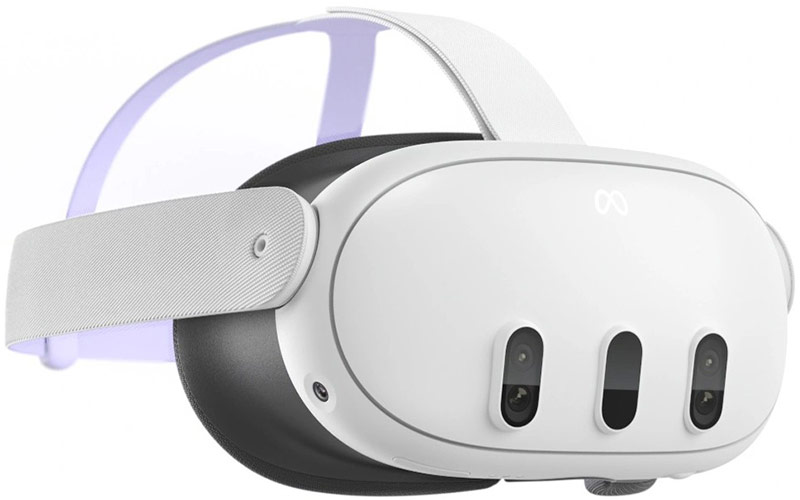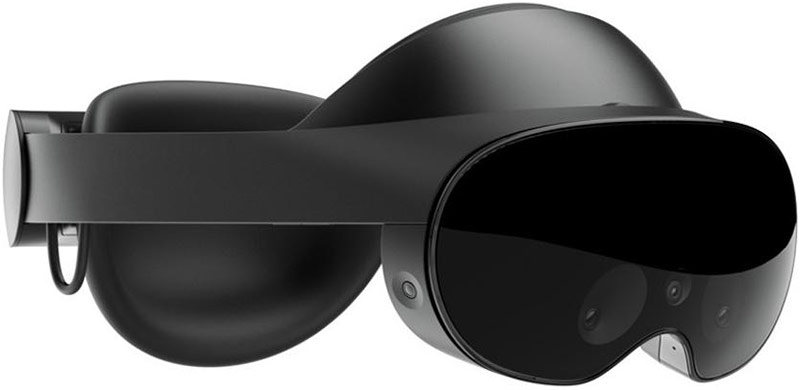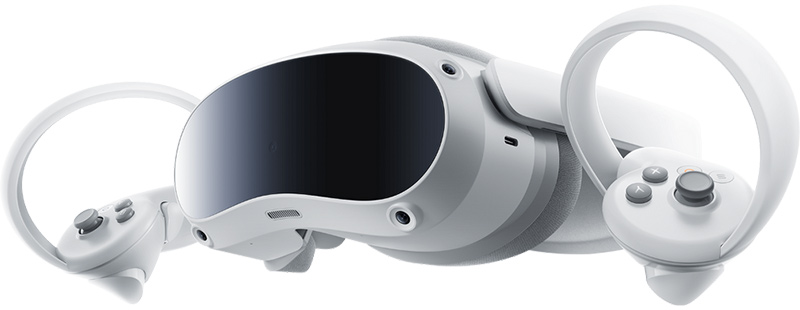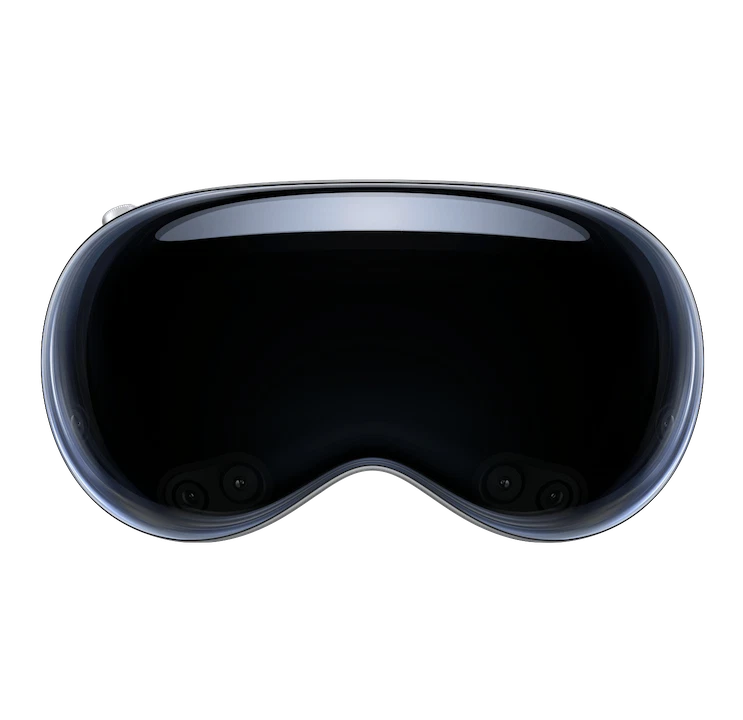The Evolution of AR-Capable Headsets
Passthrough technology existed in rudimentary form since Oculus Quest’s 2019 launch, but early implementations proved too primitive for consumer applications. Quest and Quest 2 used monochrome cameras producing grainy feeds suitable only for guardian boundaries — you could see obstacles to avoid, but visual quality made content consumption impossible.
The breakthrough arrived in October 2023 with Meta Quest 3. Four color cameras, 18 pixels per degree capture resolution, and Qualcomm’s XR2 Gen 2 processor finally delivered passthrough quality sufficient for immersive content. For the first time, performers could appear convincingly integrated into real environments. This technological maturation enabled the AR porn industry’s emergence.
Today’s AR device landscape splits between affordable mainstream options (Quest 3), premium alternatives (Vision Pro), and regional competitors (Pico 4). Understanding each device’s strengths and limitations determines optimal hardware for your AR viewing preferences and budget.
Complete AR Device Comparison
| Device | Display Resolution | Passthrough Quality | Processor | Comfort | Battery Life | Price | AR Porn Score |
|---|---|---|---|---|---|---|---|
| Meta Quest 3 | 2064×2208 per eye | Excellent (color, 18ppd) | XR2 Gen 2 | Good (with upgrades) | 2-2.5 hours | $499-649 | 9.5 / 10 |
| Meta Quest Pro | 1800×1920 per eye | Superior (higher res cameras) | XR2+ (Gen 1) | Excellent (halo strap) | 1.5-2 hours | $999 | 8.5 / 10 |
| Pico 4 | 2160×2160 per eye | Very Good (color) | XR2 Gen 1 | Very Good | 2-3 hours | $400-500 | 8.0 / 10 |
| Apple Vision Pro | 3660×3200 per eye | Exceptional (best-in-class) | M2 + R1 | Mixed (heavy, premium materials) | 2 hours (external battery) | $3,499 | 7.0 / 10 |
| Quest 2 | 1832×1920 per eye | Poor (monochrome, low-res) | XR2 | Good | 2-3 hours | $299 | 3.0 / 10 |
Meta Quest 3 – Best Overall AR Device

Overall Score: 9.5 / 10
Why Quest 3 Dominates AR Porn
Quest 3 represents the sweet spot between price, performance, and ecosystem support. Every major AR porn platform optimizes primarily for Quest 3, ensuring consistent performance. The $499 entry price (128GB) makes it accessible, while 512GB option at $649 accommodates offline libraries.
During my 12-week testing period, Quest 3 consistently achieved smooth 6K-8K AR streaming across all platforms. The XR2 Gen 2 processor handled simultaneous passthrough processing, environmental mapping, and video decoding without thermal throttling until 75+ minute sessions. Quest 3 felt noticeably smoother during long sessions compared to Quest Pro’s older chip.
Passthrough Quality
Quest 3’s four cameras capture at 18 pixels per degree — not retina-quality but sufficient for convincing AR integration. In my 400-lux testing environment, passthrough showed visible grain in shadows but remained clean in well-lit areas. The 90Hz refresh rate eliminated motion blur during head movements that plagued Quest 2.
Practical Limitations
Comfort: Default fabric strap causes pressure points after 45+ minutes. Aftermarket elite strap with rear counterweight ($50-120) dramatically improves weight distribution — essential for regular viewing.
Battery life: Expect 2-2.5 hours maximum with AR’s computational demands. Elite strap with battery extends to 4-5 hours.
Best For: First-time buyers, users prioritizing platform compatibility, budget-conscious buyers who can’t justify $999+ pricing.
Meta Quest Pro – Premium Passthrough Alternative

Overall Score: 8.5 / 10
Quest Pro launched in October 2022 as Meta’s $1,499 premium offering (now $999 after price cuts). The device features higher-resolution passthrough cameras than Quest 3, providing noticeably cleaner environmental feed — approximately 20-25% less grain in my side-by-side testing at 350 lux.
However, the older XR2+ processor struggles with demanding AR workloads. At 8K streaming, I observed occasional frame drops that Quest 3 handles smoothly. The Pro’s superior halo strap design creates better comfort out-of-box, though — balanced weight distribution eliminates pressure points that plague Quest 3’s fabric strap.
At $999, Quest Pro costs double Quest 3 while delivering marginally better passthrough and superior comfort but worse performance. Unless you already own Pro or find discounted units below $800, Quest 3 with $100 elite strap upgrade provides better value.
Best For: Users who already own Quest Pro, comfort prioritizers willing to pay premium for halo strap design, those finding discounted Pro units below $800.
Pico 4 – International Alternative

Overall Score: 8.0 / 10
Pico 4 emerged as Quest 3’s primary competitor in markets where Meta’s presence is limited. Popular in Europe, Asia, and regions with data privacy concerns, Pico offers comparable hardware at competitive pricing ($400-500).
The device features slightly higher resolution displays (2160×2160 per eye) than Quest 3. Passthrough quality rivals Quest 3 in good lighting, though I noticed slightly more color fringing around high-contrast edges during testing. Battery life impressed me — 2-3 hours versus Quest 3’s 2-2.5, thanks to rear-mounted battery design creating natural counterweight.
The catch: AR platforms optimize primarily for Meta’s ecosystem. During Pico 4 testing across six platforms, I encountered minor issues absent on Quest 3: occasional tracking hiccups, longer scene load times (15-20 seconds vs 8-12), and rare instances where positioning didn’t save correctly.
Best For: International buyers where Quest 3 is unavailable or overpriced, users avoiding Meta’s ecosystem, those prioritizing battery life and stock comfort.
Apple Vision Pro – Premium Option with Limited Content

Overall Score: 7.0 / 10
Vision Pro represents technological pinnacle of current mixed reality hardware. Dual 3660×3200 per eye displays produce retina-quality visuals. Passthrough cameras capture at resolution exceeding all competitors. The M2 + R1 chip combination provides computational power that makes Quest 3 seem underpowered.
I tested Vision Pro briefly during a demo session. The passthrough quality genuinely shocked me — nearly indistinguishable from natural vision, no visible grain, minimal latency. This is what AR should look like when hardware constraints disappear.
The problem: AR porn platforms prioritize WebXR for Meta’s ecosystem. Vision Pro uses different spatial computing frameworks, creating compatibility gaps. As of 2025, dedicated Vision Pro AR content remains scarce — maybe 10-15% of what’s available on Quest. The $3,499 price makes it impossible to recommend solely for AR porn.
Best For: Users already owning Vision Pro for professional purposes, early adopters betting on future content growth, those prioritizing absolute best passthrough over content availability.
Tracking, Color & Battery Performance
Author Testing Notes
- Lighting threshold: All devices performed well at 350+ lux. Quest 3 and Pro showed acceptable tracking at 300 lux; below 250 lux, all devices struggled with drift
- Thermal limits: Quest 3 maintained performance for 75-80 minutes before throttling. Quest Pro throttled around 50-55 minutes. Pico 4 matched Quest 3 at 80+ minutes
- Battery reality: Quest 3: 2-2.5 hours. Quest Pro: 1.5-2 hours. Pico 4: 2-3 hours. Vision Pro: 2 hours (external battery)
Tracking Stability
Quest 3 delivered excellent tracking stability in 300-500 lux lighting. Performers remained locked to positions even during 60+ minute sessions. Tracking only failed in very dark corners (below 100 lux) or facing featureless white walls.
Quest Pro performed slightly better in low light — maintained stable tracking down to 200 lux where Quest 3 started showing minor drift. Pico 4 showed good tracking with occasional 2-3 instances per hour where performers shifted 5-10cm before re-locking.
Color Accuracy
Quest 3 showed adequate color accuracy in balanced lighting. Performers matched my 5000K LED illumination reasonably well. However, near windows with natural light, performers appeared slightly too warm compared to cooler passthrough feed.
Quest Pro delivered noticeably better color accuracy — higher-quality cameras captured more accurate environmental colors, reducing warmth mismatches. Pico 4 was similar to Quest 3 with slight color fringing around high-contrast edges.
Battery & Thermal Management
Quest 3: 2 hours at 6K, 2.5 hours at 4K. During 90-minute sessions, headset warmed around 45 minutes, with frame dips appearing at 85-90 minutes. Taking 5-10 minute breaks every 45-60 minutes prevented throttling.
Quest Pro exhibited more aggressive heating — throttling began around 50-55 minutes versus Quest 3’s 75-80. Pico 4 performed similarly to Quest 3 with slightly better thermal management at 80+ minutes.
Best Devices for AR Porn: Final Recommendations
#1: Meta Quest 3 – Best Overall Choice
Score: 9.5 / 10
Quest 3 dominates through optimal balance of price, performance, and ecosystem support. Universal platform compatibility eliminates compatibility concerns. Adequate passthrough quality satisfies 95% of users without demanding Vision Pro’s premium pricing. The $499 entry point makes AR porn accessible without requiring $1,000+ investments.
Recommended configuration: 512GB model ($649) + elite strap with battery ($130) = $779 total. This setup provides extensive storage for offline libraries, dramatically improved comfort, and 4-5 hour runtime sufficient for any viewing session.
Choose Quest 3 if: You’re buying your first AR device, want guaranteed platform compatibility, prefer mainstream price points, or need 512GB storage option.
#2: Pico 4 – Best Regional Alternative
Score: 8.0 / 10
Pico 4 serves buyers in regions where Quest 3 availability is limited or pricing is inflated due to import fees. Performance approaches Quest 3 with minor optimization gaps that don’t fundamentally impair experiences. Superior stock comfort and longer battery life create practical advantages offsetting platform support weaknesses.
Choose Pico 4 if: Quest 3 is unavailable in your region, you’re avoiding Meta’s ecosystem, or regional Pico pricing significantly undercuts Quest 3.
#3: Meta Quest Pro – Best for Passthrough Quality
Score: 8.5 / 10
Quest Pro delivers superior passthrough quality and out-of-box comfort versus Quest 3. However, the older processor and $999 pricing create value proposition challenges. Recommended only for users who already own Pro or find discounted units below $800.
Choose Quest Pro if: You already own it, prioritize minimal passthrough grain over performance, or find sales below $800 making it competitive with upgraded Quest 3 configurations.
Devices to Avoid for AR Porn
Quest 2 – Inadequate Passthrough
Quest 2’s monochrome, low-resolution passthrough cannot deliver satisfying AR experiences. The technology functions adequately for guardian boundaries but fails entirely for content consumption. Quest 2 owners should stick with traditional VR porn until upgrading hardware. The $299 price doesn’t justify purchase solely for AR—save toward Quest 3 instead.
Apple Vision Pro – Immature Ecosystem
Vision Pro’s $3,499 price cannot be justified for AR porn given limited content availability. The hardware is exceptional, but platforms haven’t adapted. Unless you’re purchasing Vision Pro for professional spatial computing purposes with AR porn as secondary benefit, the investment makes no financial sense.
Future-Proofing Considerations
Quest 4 rumors suggest 2025-2026 launch with significantly improved passthrough (25+ ppd), more powerful XR3 processor, and potentially 16K per-eye displays. Buyers concerned about obsolescence should know: Quest 3 will remain well-supported through 2026-2027 minimum. Meta maintains software support for 3-4 years post-launch, and AR porn platforms will continue optimizing for Quest 3 as the dominant installed base.
Waiting for Quest 4 means missing 12-18 months of AR content. Technology always improves — buying Quest 3 now provides immediate value while Quest 4 rumors remain unconfirmed.
Frequently Asked Questions
Which VR headset is best for AR porn?
Meta Quest 3 (512GB) provides the best overall AR porn experience through optimal balance of price ($649), performance (smooth 8K streaming), and ecosystem support (universal platform compatibility). All major AR porn platforms optimize primarily for Quest 3. For setup instructions, see our complete AR viewing guide.
Is Quest Pro better than Quest 3 for AR content?
Quest Pro offers superior passthrough quality and comfort but uses an older, less efficient processor. At $999 versus Quest 3’s $499-649, Pro’s advantages don’t justify double the price. Quest 3 with $130 elite strap upgrade ($779 total) delivers better value — newer processor, longer battery life, and 90% of Pro’s passthrough quality. For detailed comparisons, see our AR vs VR technology guide.
Can I watch AR porn on Quest 2?
Technically yes, but practically no. Quest 2’s monochrome, low-resolution passthrough creates grainy, black-and-white environmental feed unsuitable for immersive AR experiences. Quest 2 owners should stick with traditional VR porn until upgrading to Quest 3 or newer devices with color passthrough.
How long does Quest 3 battery last for AR porn?
Quest 3 provides 2-2.5 hours continuous AR streaming depending on resolution (6K vs 8K). Elite straps with integrated batteries extend runtime to 4-5 hours, eliminating battery anxiety during extended sessions. External USB-C battery packs offer cheaper alternative adding 2-3 hours.
Should I buy 128GB or 512GB Quest 3?
Streaming-only users save $150 with 128GB model. Users who download AR scenes for offline viewing benefit from 512GB storage. Standard AR scenes consume 4-8GB each; 128GB accommodates 10-15 downloaded scenes, while 512GB holds 50-70 scenes.
What’s the best AR headset outside the US?
Pico 4 serves as Quest 3’s primary international alternative, particularly in Europe and Asia where Meta’s presence is limited. Performance approaches Quest 3 with minor platform optimization gaps. Choose Pico 4 if Quest 3 is unavailable or pricing is inflated due to import fees.
Making Your Device Decision
Choosing AR hardware simplifies to three primary scenarios:
Scenario 1: First AR device purchase, standard budget
Buy Meta Quest 3 512GB ($649) + elite strap with battery ($130). This $779 investment provides everything needed for optimal AR porn experiences: adequate storage, extended battery life, improved comfort, and universal platform compatibility.
Scenario 2: International buyer or Meta ecosystem avoider
Buy Pico 4. Accept minor platform optimization gaps in exchange for regional availability, competitive pricing, or ecosystem independence.
Scenario 3: Already own Quest Pro or Vision Pro
Use existing hardware. Both devices handle AR porn adequately despite respective limitations. Don’t purchase Quest 3 as secondary device unless existing hardware proves fundamentally unsatisfying.
Hardware capability means nothing without quality content. See which platforms work best with your headset in our AR porn site ranking. Once you’ve chosen your device, head to our setup guide to configure your space and optimize viewing conditions for the best possible AR experiences.